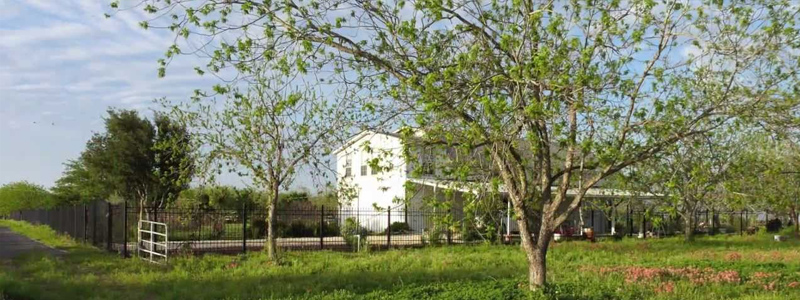How to Plant Pecan Trees in Texas
If you have come to this post on planting pecan trees, I assume you intend to plant a pecan tree and you haven’t planted a pecan tree before or you are toying with the notion of planting an entire orchard of pecan trees.
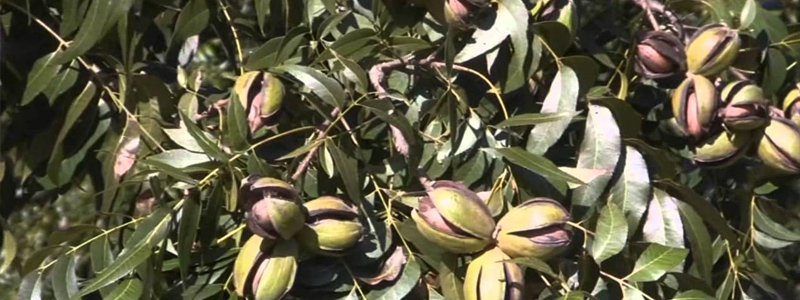
If you are on this page as a beginner, let me assure you that planting a tree of any kind is a simple process. If you are here because you want to plant an entire orchard, I must warn you that I’ve never planted an entire orchard of pecan trees, however, am willing to offer you what knowledge I have and the moral support you’re going to need to undertake such an adventure. Whatever your intent, we’ll look at the basics of pecan tree planting.
Basics of Pecan Tree Planting
Before you run down to Lowes and buy a pecan tree to plant, you should be aware of what type of pecan varieties do well in your area, assuming you are counting on producing a crop of pecans. Whether you’re planting one pecan tree in your back yard, or an entire orchard, the investment in your tree is itself substantial. The time, effort, and money that you will invest in making your tree grow and produce will be even more substantial.
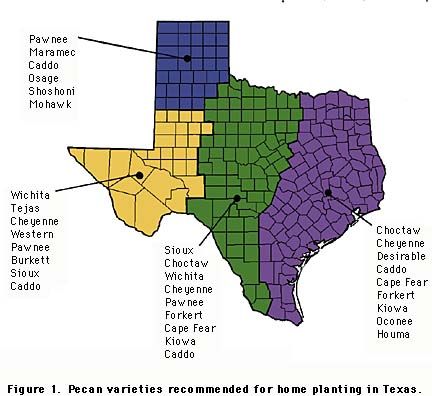
It is imperative that you plan ahead before you just stick a tree in the ground. Not only should you consider a variety of pecan tree that thrives in your area, but you should also take a look at what you are setting out to accomplish. Do you want a shade tree that produces just enough pecans for your family’s use, or are you seeking to produce an income from your pecan tree?
Where to plant your pecan tree
Pecan trees grow to an enormous size. While you don’t have the usual problems with a wandering root system that many shade trees cause, your pecan tree will eventually reach a height of eighty to a hundred feet and spread its canopy of leaves thirty to fifty feet in all directions. If you are planting a pecan tree in your yard, keep in mind that power lines that are twenty feet high will someday pose a problem if you plant a pecan tree beneath it. Your power company will be merciless in pruning your stately pecan tree into an ugly, deformed mess of greenery to keep it from interfering with ‘their’ power line.
Be wary of planting too close to your house or fence. It is hard to imagine that three-foot pecan sapling having a trunk diameter of three to five feet, but someday, perhaps when you’re too old to do anything about it, your pecan tree could literally invade your home. You should also be aware of sewer lines, gas lines, and water lines running beneath your topsoil. If you are looking at (c) planting an entire pecan orchard, follow the link at the top of this page.
When to plant your pecan tree
I personally suggest you plan your planting for mid to later February. I have read several articles suggesting a fall planting will add approximately one year’s growth to your tree, but I feel this method has its flaws. First, in order for your tree to ‘take root,’ you will need to water it. You might not be so diligent in watering your newly planted tree when the temperature is twenty degrees outside and the outside faucet is frozen up for weeks at a time.
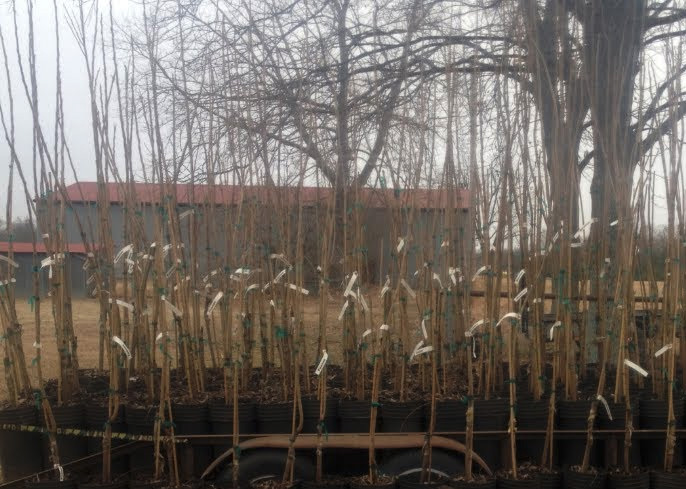
I prefer to plant my trees at the back end of winter, giving the soil around their roots just enough time to settle before the spring sunshine and warmer temperatures bring your new tree to life. It is probably safe to plant your pecan tree until mid-April. After that, the summer heat will take it’s toll and your tree will struggle to survive.
Planting a pecan tree in your yard
Hopefully, you have already read our introduction page on planting a pecan tree. You’ve chosen your variety of pecan tree, picked a suitable location, and the time has arrived to plant your pecan tree. It’s time to pick up the shovel.
Pecan trees have a central taproot whose sole purpose during its lifespan is to seek out water and nutrients in the soil, vasts amounts of water, and nutrients. It’s important to keep this mission in mind as you plant. If you are living in an area with shallow topsoil, solid bedrock, lack of a sub-surface water table, or just nutrient-deficient soil, you might want to reconsider the idea of planting a pecan tree. Regardless of how diligent you are in caring for your tree, if the right conditions don’t exist, your pecan tree will struggle.
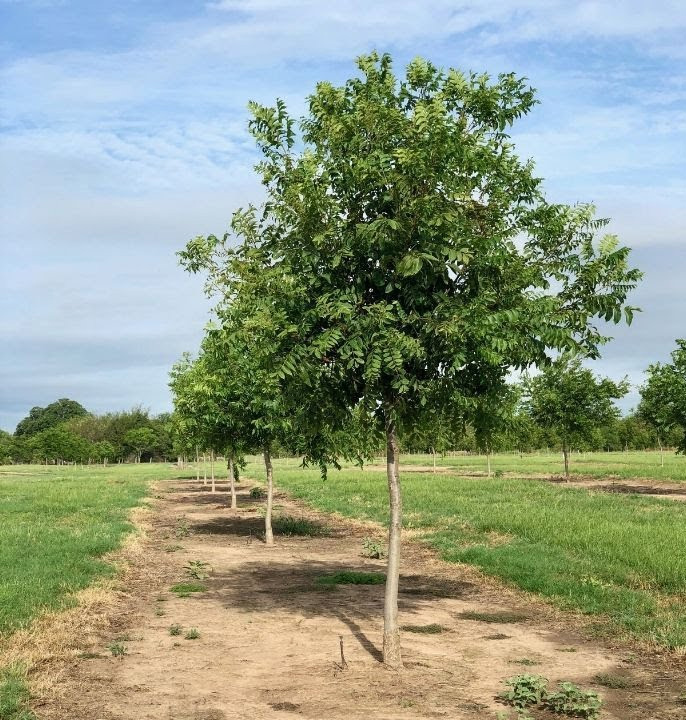
If you purchased your pecan tree locally, it probably came in a container, a ‘bucket’ with dirt covering the roots of the tree. If you purchased your tree from a distant nursery, it would more than likely arrive at your home ‘bare-root,’ with no soil protecting the tree roots. While I’ve had success in planting bare root trees, it is important to note that the tree inevitably suffered some stress and will require additional care to pull it through.
Your first and foremost chore when your new tree arrives, whether it be bare root or in a container, is to water it thoroughly. If your tree is bare-root and you cannot plant it immediately, you should dig a shallow trench and get your tree into the soil as quickly as possible. Be sure all roots are covered with soil and soak the tree roots with water.
Let’s plant a pecan tree
Dig a hole. While planting a tree is a simple undertaking, there are a couple of things to keep in mind. Unless you are planting a native pecan tree, your tree is a grafted hybrid variety, which means a branch from a specific variety of pecan tree has been grafted onto the native rootstock. When digging your hole, be sure not to plant the tree deeper than the roots of the tree.
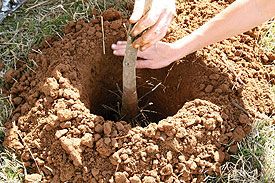 The graft, usually just above the root system, is typically recognized as a knot or a crook in the base of your young tree. If you bury the graft, the tree will put offshoots below the graft, which will be native rather than the hybrid pecan variety. Your tree runs the risk of losing its graft. You should plant your tree with at least three inches of the native trunk exposed above ground level. In other words, your graft should be about four fingers above the soil line.
The graft, usually just above the root system, is typically recognized as a knot or a crook in the base of your young tree. If you bury the graft, the tree will put offshoots below the graft, which will be native rather than the hybrid pecan variety. Your tree runs the risk of losing its graft. You should plant your tree with at least three inches of the native trunk exposed above ground level. In other words, your graft should be about four fingers above the soil line.
While care should be taken not to plant your tree too deep, the bottom of your hole should be loosened with a shovel to make it easier for your taproot to establish itself. Dig the hole two and a half to three feet in diameter to allow young feeder roots ample room to spread. Once your hole is dug, fill it completely full of water. You can take a break as you allow the water time to soak completely into the soil. This is, I firmly believe, the single most important step in successful pecan tree planting.
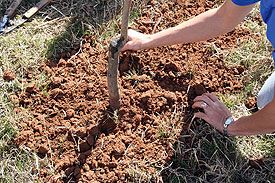 Once the water no longer stands in your hole, if you are planting a container-grown tree, gently bump the sides of the container with the heel of your hands to loosen the dirt. Grasp the tree by its trunk and lift it from the container and gently place it in your hole. If you see that your hole is a bit too deep, scoop some loose soil into the bottom of the hole. Work soil into the hole around the dirt holding your tree in place. Tamp the soil lightly to remove any air pockets. Do not pack the soil tightly around your tree.
Once the water no longer stands in your hole, if you are planting a container-grown tree, gently bump the sides of the container with the heel of your hands to loosen the dirt. Grasp the tree by its trunk and lift it from the container and gently place it in your hole. If you see that your hole is a bit too deep, scoop some loose soil into the bottom of the hole. Work soil into the hole around the dirt holding your tree in place. Tamp the soil lightly to remove any air pockets. Do not pack the soil tightly around your tree.
If you are planting a bare root pecan tree, you may need a helper, since you are basically attempting to put a one to two-inch diameter ‘stick’ into a three-foot hole. Have your helper position your tree in the center of the hole with the bottom of the taproot resting on the bottom of the hole. You should scoop loose dirt into the hole with your hands, taking care to position any small feeder roots in a horizontal position before covering them with soil. Once your hole is filled, gently tamp the soil to remove any air pockets.
You now have your pecan tree planted. With a water hose, soak the area around your tree. This will allow the dirt to settle around the roots and will also remove any remaining air pockets.
Your young pecan tree will probably need to be staked. Wind, pets, kids, and such can cause damage. You’ll need some rope, preferably cotton or nylon, and three stakes. To prevent damage to your young tree trunk, wrap an area with plastic or rubber (a piece of bicycle innertube works great.) Then loosely tie the three pieces of rope onto the protected trunk. Drive the three stakes an equal distance apart into the ground and attach the rope.
While you sit back and patiently wait for spring to bring your newly planted tree to life, keep these important tips in mind. Water your tree frequently and thoroughly during its first few years. Keep insects off your young tree. A zinc spray is essential for optimal growth, however, nitrogen fertilizer should not be applied during the first growing season. For more in-depth information on caring for your new pecan tree, be sure to visit our other sections of Texas Pecan Trees.

